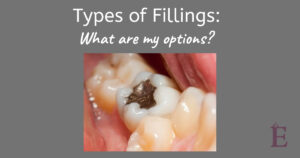When it comes to types of fillings for cavities, patients have lots of options!
Did you know that you have your “fill” of options when it comes to selecting different types of fillings for cavities? Silver is no longer the “gold standard” as today’s patients can choose from an array of dental filling materials. Based on the location of your cavity, its severity, and your dental insurance, you and your dentist can determine which of the following options works best to address all of your needs.
So, now that you know you have options, let’s explore the different types of dental cavity fillings below…
Silver, aka, “Amalgam”
About 75% of all fillings used today are dental amalgam fillings. While they may have a silver appearance, the filling is actually a combination of metals, including silver, tin, copper, and mercury. Why are amalgam fillings so popular? They are extremely durable, functional and cost-effective. Amalgam also hardens quickly, making it an efficient cavity filling. However, some patients find that the silver appearance of amalgam fillings is unsightly compared to more natural, “tooth-colored” fillers.
Composite Resins
Patients who wish to maintain a natural, white smile often opt for composite resins. These “tooth-colored” fillings consist of glass and quartz and they mirror the color of your natural teeth. Composite resins also bond nicely to the teeth and are fairly durable. However, they may stain more easily and they typically do not last as long as amalgam fillings. Also, some patients with composite resins experience tooth sensitivity.
Gold
Most dentists agree that gold fillings are, in fact, the gold standard when it comes to durability. Lasting 15-20 years, they outlast amalgams and composite resins. Consisting of gold, copper, and other bronze metals, gold fillings are typically much more expensive (up to 10 times more expensive than amalgams!) and require multiple dental visits.
Ceramics
Made of porcelain, ceramic fillings have their pros and cons. On the plus side, they are tooth-colored and aesthetically pleasing and they also do not stain quite as much as composite resins. However, they are more abrasive and much more expensive than amalgam and composite fillings.
Glass Ionomers
Consisting of glass and acrylic materials, glass ionomers are more than just a “filler.” They also perform a special function. The filling actually releases fluoride to help protect the tooth from further decay. However, a glass ionomer filling is typically less durable than others, often lasting less than five years.
Now that we’ve “filled” you with knowledge, be sure to engage in a good dialogue with your dentist about the different options available to you when the time comes to have a cavity filled.
Do you have a cavity that needs to be filled? Please contact Dr. E Cosmetic & Family Dentistry at 480-494-2435 to learn more about Dr. Janet Euzarraga’s cavity filling recommendations, techniques, and pricing.


